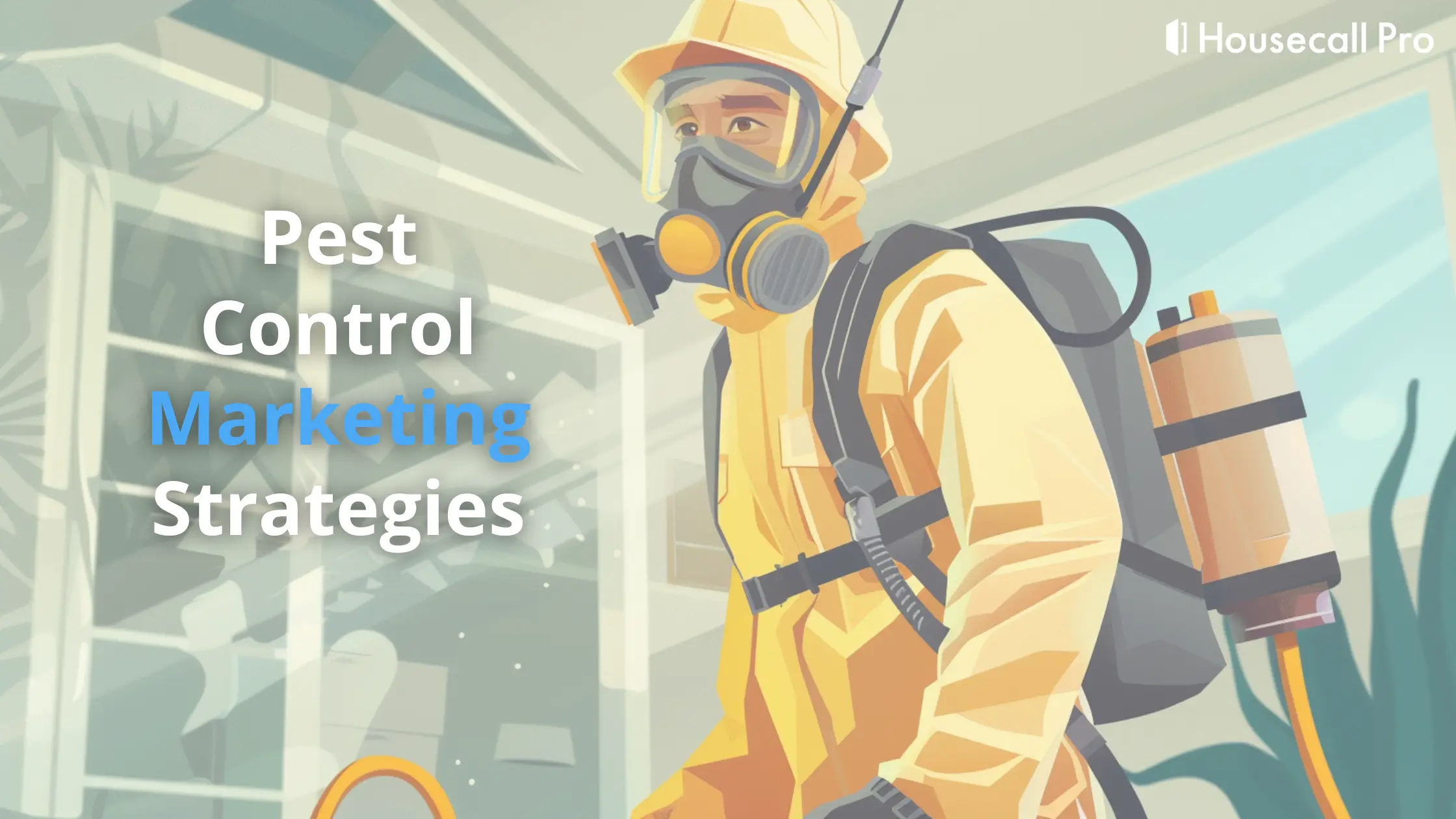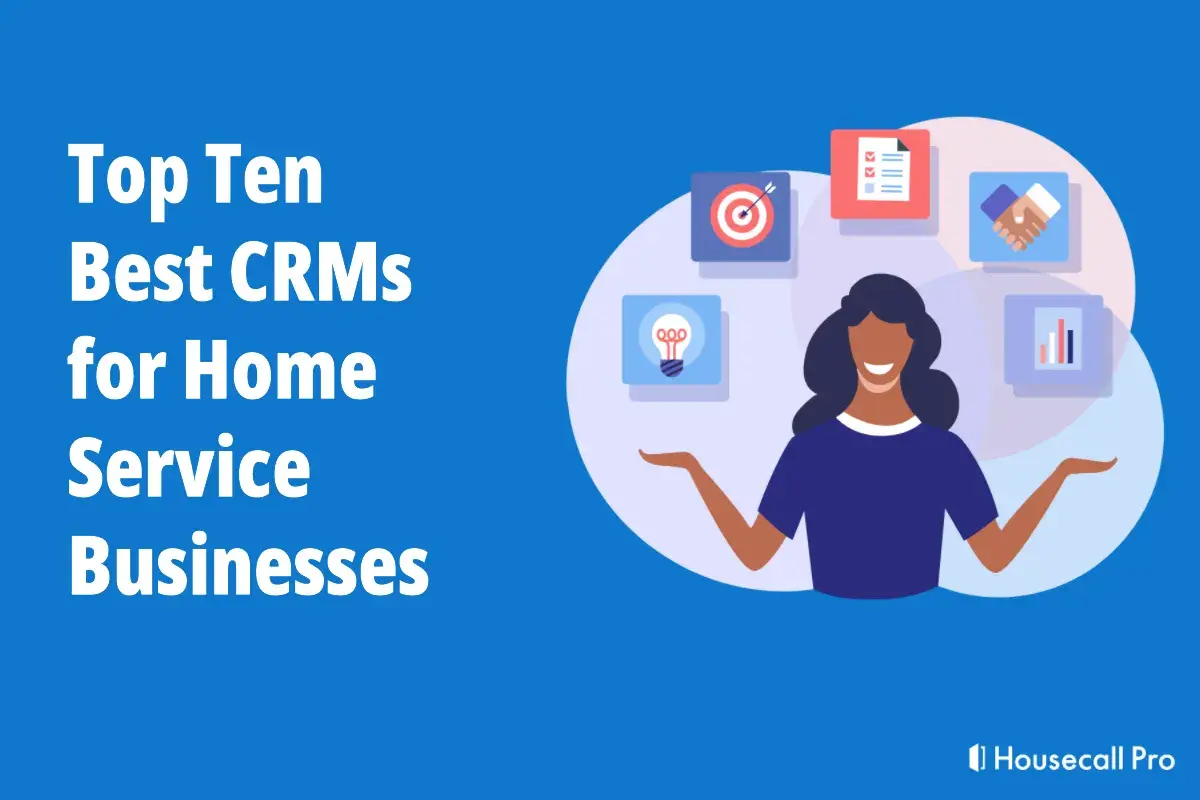
People need pest control services regularly, so your marketing campaigns and advertising must remain active. You want local consumers or businesses to think of you when the time arises for pest control needs. You also need the right pest control customer management software to keep track of your advertising campaigns and new customers.
Developing a plan of action, deciding how much to spend on each ad, and setting goals for your marketing efforts are essential to business growth and success.
- What is Pest Control Marketing?
- How Do I Advertise for Pest Control?
- 21 Pest Control Marketing & Advertising Strategy Ideas
- 1. Research Your Market
- 2. Build/Upgrade Your Primary Website
- 3. Create and Maintain a Blog
- 4. Setup a Free Google Business Profile
- 5. Maintain and Participate in Reviews
- 6. Create Social Media Accounts
- 7. Create Google Ad Campaigns
- 8. Use Paid Social Media Marketing/Advertising
- 9. Get Listed in Offline Local Directories
- 10. Add Your Business to Online Directories
- 11. Make Use of Videos
- 12. Build Connections
- 13. Create Sponsorships
- 14. Create Giveaways and Contests
- 15. Create/Build Email Lists
- 16. Create Sales Funnels
- 17. Use Online Referral/Affiliate Marketing
- 18. Monitor Your Advertising Efforts
- 19. Regularly Review Your Marketing Strategies
- 20. Manage Your Reputation
- 21. Use Automated Processes
- Grow Your Pest Control Business With Housecall Pro
What is Pest Control Marketing?
Pest control marketing is the process of using various marketing and advertising channels to build leads and customers and close sales, if applicable. It involves physical and digital efforts that make your business visible to the targeted audience via email, pay-per-click (PPC) ad campaigns, social media, videos, local directories, and more.
Pest control marketing includes:
- Pay-per-click (PPC) ad campaigns on Facebook, YouTube, Google, Bing, Instagram, X, and several other channels
- Pay-per-view (PPV) ad campaigns on other websites, pop-up windows, new browser tabs, etc.
- Email lists to capture new leads and customers
- Referral/affiliate management that lets others market and promote your ads and links to obtain leads and sales for your business for a commission
- Reputation management to maintain positive reviews and feedback that help boost your marketing results
- Website search engine optimization (SEO) to bring in new traffic via organic search results
- Blogging to build your reputation, get more exposure, and make your pest control business a leader in the industry and targeted area
How Do I Advertise for Pest Control?
There are several ways to market your pest control business, from building or upgrading your website and creating a blog to enhancing your Google Business Profile and launching ad campaigns. Strategy plays a significant role in the advertising and marketing process. You need to know your audience, develop customized ads based on goals and the audience you want to target, test out different marketing angles, and track performance for each campaign you create.
21 Pest Control Marketing & Advertising Strategy Ideas
Before diving into campaigns, you must ensure you have the right tools for the job, and everything is ready to go. There is no productive way to market and advertise your business without having quality landing pages, sales funnels, and an optimized website. You surely cannot achieve successful marketing campaigns without customer and business management software, and you definitely need payment services to get paid.
Critical software you should incorporate in your marketing strategies includes:
- Reputation management software to monitor and maintain positive ratings and reviews and to ensure customers are satisfied, even if they weren’t originally
- Home services website building software that is SEO-enhanced and custom-tailored to your pest control business while being designed to capture new customers
- Campaign management software to convert leads and create repeat customers
- Customer management software and applications to track and monitor customer behaviors and history and to tailor marketing efforts to your customers/leads
Once you have the right tools, you can begin planning your campaigns using blogs, SEO, your website, sales funnels, emails, text ads, image ads, video ads, and more. Keep reading to discover 21 marketing and advertising strategies you should use for your pest control business.
1. Research Your Market
The first step to perform when planning your marketing and advertising strategies is to research your local market, your audience, and the competition. You need to study to prepare and execute your marketing efforts mindlessly. It is vital to know how big your target market is or how far out you want to reach, who your customers will be, and what the competition is doing so you can stand out from them.
Step 1: Research Your Target Market Areas
Once you establish your target market and service area, you can begin researching the population counts to help determine your overall audience numbers. This process can include how many businesses reside in the area or the human population within each location.
The target market research phase will yield a different number than exact numbers but will guide you. For instance, you may target one city more than another due to demand and higher audience levels. At the same time, you will gladly accept customers from both areas.
Step #2: Research Your Target Audience
Once you have your target market data, you can determine who you want to target by separating businesses and consumers by categories. You can create subcategories if desired, especially since one main category can cover many variations. For instance, you’d want to market a lawyer’s office from different angles than a health/medical office.
For commercial customers, create groups/categories based on business industries so you can develop custom-tailored marketing and advertising campaigns. Some companies under a corporate name may use one pest control service nationwide for all buildings, but not all of them. You also have local businesses to target. Your marketing results will allow you to tweak and change your advertising efforts to those that generate new leads.
Your targeted commercial audience categories can include but are not limited to:
- Retail: Include superstores (Walmart, Target, etc.), department stores (Macy’s, Kohl’s, etc.), convenience stores (Seven Eleven, Circle K, etc.), hardware stores, and more
- Automotive: Add dealerships, auto repair facilities, car rental locations, etc.
- Manufacturing: Use this category for assembly plants, production facilities, etc.
- Professional Offices: Includes dentists, lawyers, medical offices, job agencies, etc.
- Property Management: Add realtors, dwelling/apartment complex managers/owners, condos, hotels, etc.
For consumers, create groups/categories based on dwelling types. That way, you have various marketing angles based on common locational problems, such as mice, ants, bees, and termites in the city or spiders, groundhogs, and bees in the country.
Your targeted residential audience categories can include but are not limited to:
- City/Urban Dwellings: Include homes residing in the city limits
- Country/Rural Properties: Use for farms, multi-acre homes, barns/storage properties, etc.
- Forest/Park properties: Add cabins and forest homes within or next to wooded areas
- Beach properties: Use for beachfront homes, residential storage buildings, etc.
Using categorical organization based on locational research helps tailor your marketing efforts to the company’s or consumer’s needs.
2. Build/Upgrade Your Primary Website
Most marketing efforts require a website to link to or reference. It is your chance to show the audience what you offer, what your pest control business is about, and why they should choose you. Above all, it can help increase your Google reputation score for better ad campaign exposure. Your digital and print ads, TV commercials, radio advertising, social media accounts, etc., will need a website to send potential clients/customers to.
Your website should include the following:
- Home page: Use it to capture your audience by summarizing your business and the services you offer
- About page: Include who you are, how long you’ve served the community, your location, etc.
- Landing pages: Use for marketing and lead capture purposes
- Locational pages: Enhance local SEO and target local marketing audiences
- Service pages: For each service you offer, create in-depth pages
- Blog: Use for social/organic SEO purposes and building your reputation (more on that later)
- Contact page: Include your business name, parent company name (if applicable), email, phone, address, and contact us forms.
A good website includes detailed name and contact information, sells your services, offers assistance, builds your reputation, and makes you the authority in the local industry. Housecall Pro’s website builder is optimized for field service businesses and search engines to maximize your online presence.
3. Create and Maintain a Blog
A pest control website is essential to business growth and achieving successful marketing campaigns, but hosting a blog is also necessary. A blog increases SEO opportunities through consistent website updates (when included in your website). It allows you to build your reputation in the community and present yourself as an authority in the industry. It also helps promote your services.
Your blog site should include the following content:
- How-to information
- Recommendations
- Knowledge about related topics (insects, rodents, etc.)
- Seasonal news and information (if applicable or desired)
- Customer interaction and your participation in it
4. Setup a Free Google Business Profile
Google uses local business profiles and associated websites to display companies in local searches and on Google Maps. When a consumer searches for pest control or wasp removal, you want to appear on the search engine results pages (SERPs) and within the sectional list of local businesses offering such services. Creating a free Google Business Profile is vital to local search exposure.
Getting displayed in the local search list is based on Google algorithms and reputational scores. The more exposure and positive feedback your business and website receive, the better your chances of getting listed.
5. Maintain and Participate in Reviews
Now that you have a website and a Google Business Profile, you must maintain and participate in customer reviews. The more positive feedback you receive, the better your rankings in search engine algorithms and the more exposure your business gets.
Actively participating in reviews goes a long way. For positive feedback, ensure you thank the customer. For negative experiences, help solve their concerns and ask them to change their review if they are happy with the results. Housecall Pro can help you by providing reviews and feedback in one location with our review management software feature.
Positive reviews boost your search engine algorithm scores for local search listings and ad campaign exposure and motivate others to use your services.
6. Create Social Media Accounts
Social media like Facebook, Instagram, X, etc., significantly impact your marketing efforts and strategies, which is also why they are called social media marketing (SMM) channels. People like and share posts, images, videos, news, etc. Word-of-mouth advertising goes a long way, too. Social media accounts are also an opportunity to create free campaigns that spread the word and influence others, such as posting a contest for the best bug dance.
Not only can you create active community participation with social media accounts through posts and free campaigns, but also provide a means for free advertising and exposure.
Creating and using social media accounts allows you to:
- Promote active participation through user-generated content (UGC)
- Create free social campaigns through active audience participation
- Include posts that link to helpful blogs on your website
- Offer special promotions for action-specific activities
- Promote sponsored events
- Receive feedback for your services
- Maintain customer satisfaction through active participation in comments and reviews
- And much more!
Studying and taking notes on customer interactions within your social media channels enables you to identify their concerns and needs, their experiences related to your pest control services, and the competition whenever mentioned.
You’ll also discover what your audience thinks of your business, your services, and the existing campaigns you created. That way, you can adjust and maximize your marketing efforts to your specific audience.
7. Create Google Ad Campaigns
At this point, you should have your website, Google Business Profile, blog, landing pages, social media pages/accounts, and hopefully, a high ratio of positive reviews. Now, you just need to start some ad campaigns. For pay-per-click (PPC) Google ads or cost-per-click (CPC) Google YouTube ads, you place a maximum bid per day or week to display your ad in various Google channels, such as Google Search, YouTube, and the Google Display Network.
Your chances of getting your ads displayed involve several Google factors, including your maximum bid per day, pest control business reputational score, and various algorithms, including your positive reviews ratio, customer activity, active participation in reviews and web content, and more.
Types of Google Ad Campaigns related to pest control include:
- Search Campaigns: Text Ads in search results
- Display Campaigns: Image ads on various websites
- Video Campaigns: Video ads on YouTube
- Smart Campaigns: Uses Google AI to find the best targets to display your ads
- Performance Max Campaigns: Goal-based campaigns with access to all Google Ads inventory
8. Use Paid Social Media Marketing/Advertising
You may already have social media accounts to promote your name and services, but you also need social media advertising, often called “paid social” marketing. Paid social marketing is also part of the SMM spectrum and provides visibility on other pages within the social media platform.
Social media advertising lets you specify your target audience, and the platform does the rest, displaying your ads based on customer information, their view and interaction history, and their interests.
Using paid social media advertising includes but is not limited to:
- Image ads: Appear in feeds and generally include action buttons (Sign Up, Get Now, etc.)
- Video ads: Appear in feeds and often include action buttons (Sign Up, Click Here, etc.)
- Sponsored Ads: Includes video/image ads looking like a regular post and designed to boost exposure, likes, and comments, but it also has an action button
- Text ads: Appear in audience feeds like a typical post
- Influencer Ads: Paid ads to local influencers to market your business
- Carousel Ads: Appear in feeds and include several images/videos for each ad
- Story Ads: Appear in various stories and usually last for 24 hours
Each social media platform has unique ad options, varying in cost and type. Depending on your paid social strategies, some may work better than others.
9. Get Listed in Offline Local Directories
Another part of your marketing strategy involves getting listed in local directories, such as phone books, local commerce pamphlets, and online directories like Yelp, FourSquare, Nextdoor, etc.
Few people use paper directories today, but enough still do. Those same people who grab the phone book or local business pamphlet can significantly grow your pest control business. They contact you, you perform the required services, and they spread the word to many others who contact you, too. Leaving this option on the table means your competition may get many more leads because they used paper directories when you didn’t.
10. Add Your Business to Online Directories
Despite older marketing and advertising techniques that still apply today, the digital world has become the norm. Consumers sift through online directories, use search engines to find local pest control services and respond to advertising tailored to their needs. Online business directories are an excellent source of free advertising.
According to Serpwatch, 70% of consumers shop locally to boost the local economy. One way they do that is to use local directories based on their city or municipality. Like offline directories, online directories bring new customers who refer your services to others. The process repeats, and you obtain growth without cost when using such directories.
11. Make Use of Videos
According to the Association for Talent for Development (ATD), people remember 50% of what they visually see and hear and only 10% of what they read. Creating videos for YouTube, Vimeo, etc., is an excellent way to market and advertise your pest control services. Use your videos on social media, such as Facebook and Instagram, for consumer audiences and LinkedIn for commercial businesses to expand your customer reach.
Overall, videos increase audience participation, leading to more attention and leads. You can help others through guidance and tips and present offers to motivate responses. Making videos can also position you as an authority in the industry within your area. Videos double your chances of getting organic leads and can also give you marketing leads you can track if you use Housecall Pro home services software.
12. Build Connections
A significant part of marketing involves building connections throughout the community and expanded areas. Associating with other businesses allows you to gain valuable referrals through such connections.
In addition, building strong relationships means you can get more work. Many businesses in various industries, such as residential or commercial cleaning and property management companies, often need pest control services.
Ways to build strong relationships include but are not limited to:
- Become a member of your local chamber of commerce
- Attend and get booths at expos and shows, such as home and garden shows, spring and flower shows, and home-building expos.
- Participate in local events (street fairs, parades, balloon fests, cookoffs, etc.)
- Join local Reddit pages
- Sponsor a local business or initiative
13. Create Sponsorships
Sponsorship is an excellent way to get your pest control business name out in the public eye. Sponsoring an event, group, or business through financial donations or gifts is the act of supporting others, which resonates well with consumers and businesses alike. It’s one thing you can do to separate yourself from the competition. A good reputation usually means good outcomes, although there is no guarantee.
Sponsoring can include but is not limited to:
- A local sports team like high school football or little league baseball
- A sporting event such as a local tournament or competition
- A local club like 4-H, arts and crafts, or even litter control
- A public event such as a balloon fest, rib cookoff, car show, etc.
- A specific cause like neighborhood watch, medical research, breast cancer, etc.
14. Create Giveaways and Contests
An excellent marketing initiative is to create contests and giveaways. Everyone loves free things, especially if it’s money. The anticipation of a contest is also very exciting for consumers. However, be sure to give everyone something for their participation as a thank you. Most people hope to win the contest and can turn to disappointment if they don’t. A free handout shows you care about them, and the gesture often resonates.
Offering giveaways to your targeted audience is a surefire way to increase your visibility.
Simple giveaways can include things like:
- 50% off a selected service to the first 200 recipients
- Free bug-repellant sprays
- Humane mouse traps
- Keychains
- Stickers
- Magnets
- Pens
- Free inspections
- And more
Pass out simple giveaways at fairs, car shows, and other public events. Incorporating your branding on them increases their visibility.
Contest Giveaways can include items such as:
- $50 gift cards
- $400 cash prize
- Free exterior home treatment
- A 3-day stay at a resort
- And more
You can combine contests with giveaways or make them a separate activity with one prize. You can create video contests for a monetary award. Use your social media marketing to promote the opportunities, letting the social media platforms take control and advertise your pest control business through public interactions.
Get In Touch: 858-842-5746
Let us earn your trust
On average, Pros increase monthly revenue generated through Housecall Pro by 50% after their first year.
See plan options and feature breakdown on our pricing page.
15. Create/Build Email Lists
Email lists are a powerhouse for marketing and advertising campaigns. You want to wait to push your services but connect with the audience, get them to know you through information, how-to’s, giveaways, etc., and then gradually roll into your services. You need to build trust before you attempt to close sales, or most of your subscribers will turn away. Existing customers require a different structure, as you’ll see below.
Using Email Marketing to Get New Customers
Several email marketing platforms exist that organize your email campaigns and put them on autopilot. Mailchimp is highly recommended, especially for beginners, because of its guidance and powerful marketing features. Mailchimp includes many online tools designed to increase sales with stunning visuals and compelling text. Their proprietary Customer Journey Software includes automation triggered by the consumer’s or business’ behavior. The software also offers plenty of help to close sales, complete abandoned carts, turn leads into customers, and more.
You can also use Zoho Campaigns, ActiveCampaign, or other similar email marketing powerhouses.
Using Email for Existing Customers
Emails differ for existing customers but are still part of your marketing and advertising initiatives. You’re not trying to build trust or gain new customers; you’re trying to maintain and keep existing customers and gain new referrals from them, too.
Housecall Pro’s automated email marketing and management software helps drive repeat business and bring in more referrals with its innovative, automated emailing system. You can integrate tags and customer lists directly into MailChimp and send emails through their automated processes. Add custom campaigns to specific groups or customers from your Housecall Pro Software and send follow-ups automatically once you complete the needed services. Remind them of upcoming appointments and invite them to post reviews.
16. Create Sales Funnels
Sales funnels are the key to many successful marketing and advertising campaigns. It’s a journey that starts with an ad (marketing funnels) and leads the consumer through different steps (sales funnels) to reach the closing process.
First, you motivate the viewer to take action by giving them something they would want or need in exchange for their email, such as a free ebook explaining how to prevent bug infestations or offer them access to a free webinar on preventive measures to protect their home investment.
Next, you present a second ad page offering a discounted upsell. After that step, you can add one or more offers that include something free and valuable.
Third, you email those who signed up for your group-targeted newsletters, providing helpful information, exceptional opportunities, and advertisements for your other services.
Sales funnels are a group of marketing channels designed to capture qualified leads, build email lists to promote your services, and close sales. Email lists filled with targeted subscribers are a potent marketing tactic, keeping your audience informed and educated and repeatedly reminding them of your pest control services.
The best way to achieve high-count email lists and qualified leads is to use targeted sales funnels.
17. Use Online Referral/Affiliate Marketing
One of the most creative ways to advertise and market your business is to let others do it for you. Social media marketing utilizes it, but so does creating a referral program. If you give people money to bring in new paying customers, it is well worth the expense. Furthermore, payouts can be higher because there are no costly advertising expenses other than using some of your successful visual and textual ads. Besides, the more you give others to deliver buying referrals, the more they will want to help!
There are three types of online referral marketing: general links, text ads, and image-based ads. Image-based ads offer the best opportunities, but all three options can effectively be free advertising mechanisms.
Ways to Offer Affiliate Marketing include:
- Unique referral links provided to customers from your website (would require registrations)
- Unique referral links sent through your email lists
- Join an affiliate website like ClickBank or Commission Junction and let its registrants promote your services using your ads and links.
The easier you make it for customers and non-customers to promote your business, the better the results will be. Provide tools you know work, and ensure consumers are paid well for their efforts.
18. Monitor Your Advertising Efforts
Executing your marketing and advertising campaigns is only as good as the effort you put into them. Once you launch various campaigns, monitoring and tracking them for performance and any improvement needs is essential. A/B testing is part of that process. You run two slightly different campaign ads or emails and determine what works best so you can duplicate its success.
There are also marketing agencies designed to promote your pest control services through PPC campaigns, email marketing, custom content creation, social media marketing, conversion rate optimization, and even local SEO. Check out Housecall Pro’s 25 Best Home Services Marketing Tips & Strategies for more details.
19. Regularly Review Your Marketing Strategies
It is one thing to launch and review several marketing and advertising campaigns with the hopes of growing your customer base. Still, you must monitor and review your marketing strategies to evolve.
This process is different from monitoring your advertising efforts. You must be innovative and look for ways to apply advertising from new angles and with new sources to find new opportunities and campaigns to grow your business effectively.
Some newly created advertising methods work better than others, and you should optimize your ads and marketing strategies to fit those new opportunities and processes. You must find new advertising ways to challenge the competition for any marketing strategy.
Reviewing your marketing strategies can include:
- Monitoring how others are advertising their brand and what creative sources they use
- Researching successful home service companies by searching for them and learning how they are marketing their business
- Regularly search for “new marketing techniques and topics” to stay up to date on the latest methodologies
- Register for marketing newsletters
- Research ideas that hold proven success, such as CallRail call tracking software
20. Manage Your Reputation
Reputation management isn’t directly related to marketing and advertising, but it does play a role in your business’s growth and marketing efforts. Your existing marketing and advertising campaigns will only succeed if you have a good reputation in your community. Therefore, review management software should be a regular part of your campaigns.
Consumers conduct extensive research (mostly about information and reviews) on a business when looking for services they offer. BrightLocal’s 2024 local consumer review survey states that 33% of consumers ‘always’ check for reviews on local companies while 42% ‘regularly’ check, and only 3% ‘never’ check local company reviews.
21. Use Automated Processes
Automating processes within your business saves time and lets you focus on other essential elements, such as delivering the best customer service possible. Automation is commonly used for marketing and advertising, including mail and email list management, ad tracking, reviews, post-service follow-ups, and many other processes.
Automated processes used today include:
- Marketing
- Advertising
- Customer management
- Mail and email lists
- Ad tracking
- Post-service follow-ups
- Reviews
- And more
The old way was to copy customer information or manually enter details from a sale, quote, or lead into the software. You had to use scripting and code to integrate connections between databases, spreadsheets, and forms. You also had to hand-write or type up quotes and invoices and then add them to the software. Finances are another example.
That’s a lot of manual work and time. Now, the processes work on autopilot and integrate everything automatically. However, automation is only as good as the software you use.
Grow Your Pest Control Business With Housecall Pro
As you grow your marketing and advertising efforts to obtain more customers, you can see that there are many options and recommendations available to you. Each one plays an essential role in growing your pest control business.
Creating and monitoring ad campaigns, maintaining your reputation, optimizing your website/blogs, planning and executing strategic ad campaigns, using social media marketing, and all other recommendations work together to create a powerhouse of marketing initiatives that generate actual results.
Housecall Pro’s pest control software helps save valuable time and get your business where it needs to be to grow successfully. From customer management software and one-click invoicing to automated email lists and 24/7 online booking, you get everything you need to develop and maintain an efficient pest control business. Get a FREE 14-day trial of Housecall Pro Business Software today!






